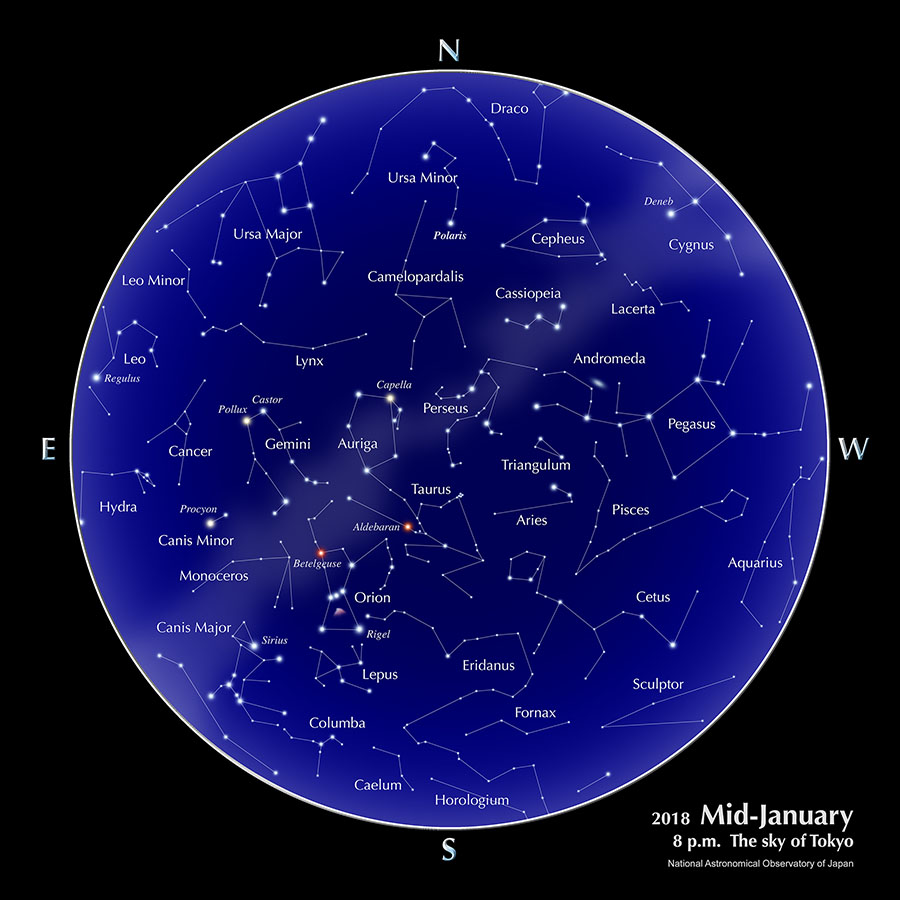The sky of Tokyo, Calendar, Planets (January, 2018)
The sky of Tokyo

Calendar (January)
| 1 | New Year’s Day [Ganjitsu] (national holiday) |
| 2 | Greatest Western Elongation of Mercury / Full Moon (This year’s largest Full Moon) |
| 3 | Uranus at stationary point / Earth passes perihelion |
| 4 | Quadrantid Meteor Shower peaks around 5:00. (For Japan, the best visibility will be before dawn on the 4th. About 20 meteors per hour are expected. The Moon is bright, so conditions are bad.) |
| 8 | Coming-of-Age Day [Seijin-no-hi] (national holiday) |
| 9 | Last Quarter Moon / Venus at superior conjunction |
| 17 | New Moon |
| 25 | First Quarter Moon |
| 27 | Occultation of Aldebaran (Part of the Tohoku region and Hokkaido) |
| 31 | Full Moon / Total Lunar Eclipse (Reference: Local Prediction of Lunar Eclipse) |
The days for the peak activities of the meteor showers are based on the predictions of IMO(International Meteor Organization).
Planets
- Mercury
- Mercury is positioned low in the southeastern sky just before sunrise. It reaches greatest western elongation on January 2. From December 23 to January 8, 30 minutes before sunrise, Mercury’s elevation as seen from Tokyo is higher than 10 degrees, making observations easy. After mid-January, the apparent position of Mercury is close to the Sun, making observations difficult. From December 23 to January 8, its brightness is 0.4 magnitude to -0.3 magnitude.
- Venus
- Venus is difficult to observe because it is located in almost the same direction as the Sun as seen from the Earth. It reaches superior conjunction on January 9.
- Mars
- Mars moves east (direct motion) in the constellation Libra, and it can be seen before sunrise moving from the southeastern to southern sky. Its brightness is 1.5 magnitude to 1.2 magnitude.
- Jupiter
- Jupiter moves east (direct motion) in the constellation Libra. It can be seen before sunrise moving from the southeastern to southern sky. Its brightness is -1.8 magnitude to -2.0 magnitude.
- Saturn
- Saturn moves east (direct motion) in the constellation Sagittarius. It is located low in the southeastern sky just before sunrise. At the end of January, 30 minutes before sunrise, Saturn’s elevation as seen from Tokyo becomes higher than 10 degrees. Its brightness is 0.5 magnitude to 0.6 magnitude.
Reference: Ephemeris Computation Office, NAOJ
With the “Sky Viewer” you can easily explore the appearance of a typical urban night sky (planets and constellations are visible). The Celestial Phenomena section of the glossary explains the planetary phenomena terms: greatest elongation, opposition, conjunction, stationary, etc.